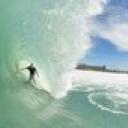beach nourishment for surfers


Andrew .
From where are they going to get the sand?
I am sure surfers will like a 'wave focussing sand slug'
Phil
And heres me thinking the 'wave focussing sand slug' was extinct.


Here is a link to a youtube vid by Tom Eady documenting the Kingscliff beach erosion.
kingsclifferosion


The Swansea channel was dredged some time ago and the sand placed onto nine mile beach off the Golf course.
It was unfortunate that we had two east coast low BOMS occur in succession -the NE swell and wind sent the sand straight south and back into the channel again. ( what can go wrong will go wrong -always). I lobbied for that sand to be placed in bags out from the beach location that it was placed - but I expected too much too soon as the process was in place. (about 1999 after Andrew's first symposium?)
Blacksmiths breakwater and the channel had the best banks ever for a good time after that.
A deep water outfall for the Belmont waste treatment works had gantry frames taking sand slurry out to the storm bar.
The resulting lefts and rights off this sand nourishment at that point was legendary and I have some pics I will track down and post.
They were two unintended benefits for good surf that occurred due to everyday works needed. (the boaters were a bit peeved though for one of them)
Oh .. if anyone has done any sandblasting by water or air , they would realize the sandburns that guy in "sand glorious sand " would be suffering. It might have been less dangerous to have just put a belt sander on his back? I hope it was just a photoshop gag!


Andrew I have posted this for discussion as it seems a easy way of accumulating sand ??
Steve,
after your mention of anti-scour matting I did a bit of a search and the results are HERE.
In particularCLICK HERE was interesting.
The words
"Erosion control mats are designed to work with nature in the building of fiber-reinforced underwater berms. Such berms reduce the impact of wave energy, thereby allowing a natural renourishment of beach sand from transported material. In coastal applications, the mats provide two actions:
The berm builds up and slows down wave action, diminishing erosion.
The slower wave action slows the sand in the waves and causes it to be deposited on the beach side of the berm - eventually rebuilding the beach."
attracted my attention as a way of building a "claytons reef". - which the sea builds for you?
The main threat might be the plastic as it looks like shredded plastic bags?
I don't think you would like the idea of leaving your reef out and only using the antiscour as a way of sand accumulating and staying as a "bombora" though?


Andrew,
ABC North coast radio mentioned on its news today that Byron Shire Council has just received a $328,000 grant to put towards the Belongil Beach erosion problem.
It is a pity that stretch of coast gets very little swell, unless it is a north east swell.


Think it was a bit more than that...http://www.farnorthcoaster.com.au/news/10717/government-grants-738000-fo...


Apologies if this is discussed elsewhere on these forums (link a brother a up if you know!), but, what are the tangible economic and social benefits of artificially creating a "awesome" wave zone to a city/shire council? And, not only what are these benefits, but do they significantly outweigh the financial costs, as well as any possible social costs to the entire community (surfing & non-surfing), both initial and/or ongoing?


Here you go mowgli.
clickhere
Alakaboo you are right it is $738,000.
There is a post showing how to create a hyperlink.


Thanks mate. That was a really well-researched and written article (I should really re-consider buying surf mags again!). I guess the problem now is to get all those lazy surfers organised and sober to do something about it! But I guess to play devil's advocate a bit longer, it appears that much more research concerning the impacts, whether positive or negative, upon the wider community must be conducted before getting all excited about creating man-made reefs.
A few questions to be asked would be, where should such structures be created - in major metropolitan locales where the construction cost-recovery times are greatly reduced or further afield in order to entice surfers heading away from already crowded centers? If one is going to cite the indirect monetary benefits of a particular surfing spot, it would also be important to estimate other costs (i.e. other than direct construction costs) associated with creating an artificial break or artificially nourishing an existing break. For example, if a few reefs were built along the massive stretch of straight beaches between TOS and Burleigh Heads, the GC's noteriety (sp?) as a wave drenched haven, both nationally and internationally, would greatly increase and in turn bring in more surfers. Besides the obvious increase in dollars spent, there would also be a greater need for infrastructure and other essential services an accommodation etc. These at first seem like a good thing but it could be debated whether an increase in population is what the GC or other major metropolitan area's really need (not to mention adjacent ecological systems). There's also flow-on effects from changes to water currents, sand build up areas, fishing industries blah blah b-blah ;)
My point being that before everybody gets all excited about the potential over-frothing that artificial reefs will create, I think it's important to really think hard about whether the positives will significantly outweigh all the potential negatives.
Also I probably should've started a new thread for this. My bad!


guys, please also see the link to this topic..on a youtube video..entitled.."making waves at Cronulla"
thanks Dr dip


I personally think South Straddie is the perfect example of beach nourishment creating a prime surf spot. There seems to be a good number of elements that contribute to the wave quality such as the bathymetry of the seaway and its surrounding area, the directions of swell it receives, but the main reason it is so consistently a world-class beach break is the regular supply of sand through dredging on the southern side of the seaway, and pumping it out on the northern side at Strad. It breaks boards at 2ft, holds up perfectly to 8ft, it sucks in every inch of swell available and is as consistent as they come.
Now if only we could convince the poor excuse for a council to construct a few more of these on the Goldy (Palmy, North Kirra etc?) we'd be able to spread the ridiculous crowds out a bit more!!


MY name is Peter Gilmore, I am a first time contributor to this forum. age is 51 nearly 52. I live in Mandurah, Western Australia and have noticed sand being pumped across the estuary entrance for the last god knows how many years. The side too which the sand is pumped would require very little in the way of repositioning the sand out fall to help the already existant sand banks, that just don't quite do it since the estuary entrance was dredged some 30 years ago(the old Srewart street break. I am extremely interested in forming a local group to start the ball rolling after watching and reading about Andrew Pitts plans for Cronulla in NSW. As I said sand is already being pumped and now there is a large marina nearby with Holiday accomodation units overlooking the beach. you can see the ewell come in and raise up, but most of the time it just does not break, unless it is an extremely large swell, which only happens a few times a year.


G'Day Pete,
The sand slug at Cronulla - which Andrew Pitt is organising - is running a bit late due to the dredges being held back at another project. Not sure when the slug will go in. From your point of view I imagine it'd be good to know what the results of the slug are before formulating your own plans for Mandurah.
I'll contact Andrew and see what the estimated date for the slug is.
Stu


Thanks Stunet, Have found the sand movement info on line which is approx 100.000 cubic metres of sand per year. I have also got the name of the man in charge of the sand pumping outfit. My only drama is that I work 3 on and 1 off miles away from home. Calling anybody in the Mandurah area to help out. Hopefully the dredge has started in Cronulla now as it is May. I will check site for reponses.


peter-gilmore wrote:Calling anybody in the Mandurah area to help out.
Hi Pete,
Are you still pursing this idea?


Beach nourishment is adding sand (truck, barge, pipeline) to the beach in response to shoreline erosion, retreat or realignment. Done right, beach nourishment(above the shoreline) and shoreface nourishment (below the shoreline) can provide local surfers with better waves at no extra cost$.
A Dutch super bank, sand only, was shaped at Scheveningen in 2010. It was best in the 1st month, but lasted up to 3 months. A similar project occurred in St Augustine Beach Florida in 2005 with excellent banks for up to 3 months. Both campaigns provided peeling, tubing, point-like waves. Of interest to larger wave climates, a shoreface nourishment project in Newport Beach USA in 1992, placed a humplike mound just beyond the wave breaking zone, it lasted up to 6 months, good surf the whole time, plenty of peaks.
Just approved by Sutherland Council, a (shoreface) beach nourishment campaign will include a ‘wave focusing sand slug’ at Cronulla Beach Australia this August 2011. The additional sand will be placed within a carefully designed template in water depths of -4m to -8m, just out beyond the normal wave breaking zone. By design, most waves will not break over the sand slug, I anticipate peak-like waves shaping up in the shoreward lee of the sand slug. Depending on the frequency and energy of storm events, good banks should provide for 3 to 6 months.
Of key importance… No extra cost, Better waves, No lasting impact.
I would be interested in hearing of your experiences (positive & negative) with sand nourishment projects in your area.